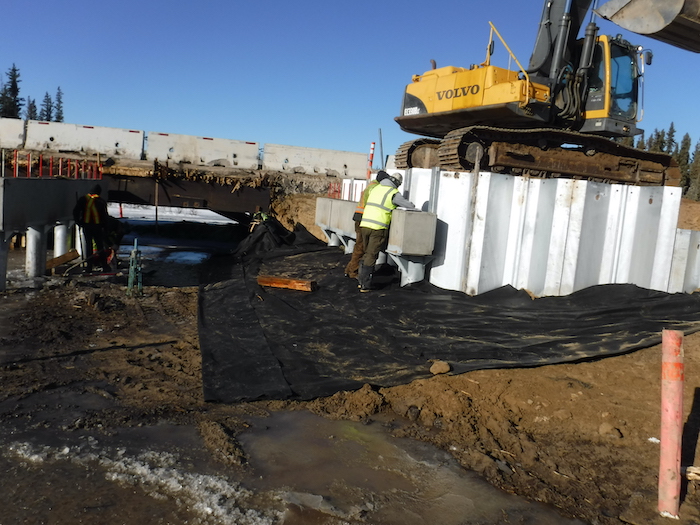
Resilient roadways
September 6, 2023
By Reda Aiouch and Jeff Nelson
Remote infrastructure needs to meet changing demands.

This deck uses stainless steel rebar to improve corrosion resistance. Photos courtesy WSP in Canada.
Evolving patterns of movement for people and goods, along with climate change, are forcing engineers to look at Canada’s roads and bridges differently. This is especially the case in the North, where climate impacts are more prevalent, with an increasing frequency of environmental devastation.
The engineering community has to adopt new ways of thinking to ensure infrastructure assets are usable for the long term. They need resilient solutions to enhance or extend the ability of a roadway to serve its community.
How we got here
Climate factors, such as shorter freeze/thaw cycles and more frequent extreme weather events, have exacerbated the need for greater resiliency, both in the development of new projects and in the maintenance of existing roadways. Sustainability in engineering has quickly transitioned from a ‘should-do’ to a ‘must-do.’
While the impact of climate change plays a key role in the need for greater built-in resiliency throughout Canada’s transportation network, however, it is not the only factor. With increased costs of construction and broad societal costs associated with loss of use, the value of infrastructure has never been higher.
This reality has led to an increase in awareness of the value of resiliency. A relatively small increase in project cost can yield significant savings over the life of a structure, in terms of longer service and reduced maintenance costs.
A small increase in project cost can yield longer service and reduce maintenance costs.
Driving change
The engineering sector is not driving the trend to incorporate greater resilience into assets. Rather, clients and communities are demanding it, builders are suggesting improvements to construction details and products and governments are updating regulations, to ensure key transportation infrastructure can survive stronger and more frequent storms. Engineers, in turn, are contributing by revising their design guidelines and codes to require resiliency.
WSP recently worked with a client who asked the firm about analyze two bridges in a parkland setting for the impact of a one-in-500-year flood event, so as to replace them with more resilient structures. As it happened, it was not feasible to pass that particular event with an economical design that met the park’s other requirements, such as keeping the required grade raise within the road right-of-way to minimize the area disturbed by the road and bridge, but WSP’s team did incorporate details to make raising the bridges easier in the future, as well as converting the abutments to piers, so the number of spans could be increased.
Although WSP was unable to create a solution that fit the allotted project budget, the client gained a greater understanding and appreciation of what it would take to create bridge assets that could withstand the damage of the most severe weather events.

An abutment with driven pile foundation and galvanized sheet pile backwall offers a service life of more than 100 years. Photo courtesy WSP.
Product innovation
Stainless steel and low-carbon or chromium-reinforcing steel, while not necessarily new, are good examples of products that can now be substituted for more conventional and less resilient construction materials, such as black reinforcing steel. These materials offer increased corrosion resistance, which boosts the resilience of reinforced concrete in severe exposure environments.
While these types of reinforcement entail a higher cost per kilogram than conventional reinforcement, their higher strength results in a smaller overall quantity being required, which can help offset costs. And when long-term service life is considered, these materials can end up being cost-comparable to black reinforcement, thanks to their increased resiliency and durability.
There are also new products and technologies coming to market on a regular basis. It is important to evaluate them and discover how they may help in the delivery of more sustainable projects.
Bridges on deep foundations have generally survived better in the wake of sustained flooding.
Impact on engineers
Beyond adopting new products and technologies, engineers must also change other aspects of their work.
By way of example, hydraulic modelling has to account for wider temperature ranges, to ensure bridges can survive the fluctuations in temperature and high stream flows associated with larger and more frequent flood events. Engineers must understand how more frequent freeze/thaw cycles under the levels to which bridge piles are buried will affect the structures. There are also concerns related to fluctuations in tundra depths, which are already wreaking havoc on roadways in Northern Canadian communities.
Fortunately, engineers are already seeing positive results from their work. In British Columbia, for example, bridges supported on deep foundations have generally survived better in the wake of sustained flooding. While the structures do suffer damage, they can be repaired and returned to service more quickly, reconnecting communities that have been cut off. The floods of fall 2021 were a testament to how vital such resilience measures are.
Building in resilience will enhance the sustainability of Canada’s transportation network as changes in weather patterns become more severe. It is imperative for engineers to do everything possible to ensure vital infrastructure can withstand the forces of nature and allow communities to remain accessible, connected and safe.
Jeff Nelson is a senior bridge engineer and Reda Aiouch is a bridge operations manager for Western Canada, both with WSP in Canada. For more information, visit www.wsp.com. This article originally appeared in the July/August 2023 issue of Canadian Consulting Engineer